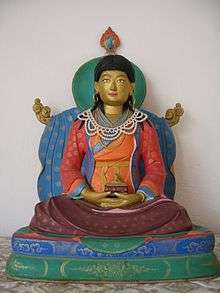Kunzang Dekyong Wangmo
| Sera Khandro Kunzang Dekyong Wangmo | |
|---|---|
| སེ་ར་མཁའ་འགྲོ་ཀུན་བཟང་བདེ་སྐྱོང་དབང་མོ། | |
 A statue of Sera Khandro | |
| Religion | Buddhist |
| Lineage | Nyingma |
| Temple | Sera Tekchen Chokhorling[1] |
| Other names | Bde-baʼi-rdo-rje, mDo-med mkhaʼ-spyod, dBus-bzaʼ mkhaʼ-ʼgro kun- bzang bde-skyong dbang-mo |
| Personal | |
| Nationality | Tibetan |
| Died | dbyi shod dpal gyi ri bo che |
| Religious career | |
| Reincarnation | Yeshe Tsogyal |
| Students | Dudjom Jigdral Yeshe Dorje, Chatral Sangye Dorje |
Sera Khandro Kunzang Dekyong Wangmo (1892–1940) was a Tibetan Buddhist teacher.[2] She taught, among others, the First Adzom Drukpa, Drodul Pawo Dorje.[2]
Sera Khandro was born into a rich family, but ran away at the age of 14 to escape an unwanted engagement and to follow the Vajrayana teacher Drime Ozer, who was then in Lhasa on pilgrimage from Golok in Eastern TIbet.[3] She returned with him and his followers to Golok, where she lived in poverty; there she became life partners with Garra Gyelse.[2] [3]
Garra Gyelsel disliked her terma revelations, and this caused Sera Khandro to become sick.[3] Her health returned when she went back to Drime Ozer with whom she subsequently revealed the treasure scriptures, or terma, for which she is known.[3] From when she was young she had experienced visions of Vajravarahi and exhibited many confirming indications of being a treasure revealer, a terton. This meant that she was destined to reveal treasure scriptures, or terma, said to have been concealed by the eighth-century Indian mystic Padmasambhava and his consort Yeshe Tsogyal.[3]
She was a teacher to many leading Nyingma lamas, including Dudjom Jigdral Yeshe Dorje and Chatral Sangye Dorje.[3]
She is considered an emanation of Yeshe Tsogyal.[4]
In Sarah H. Jacoby's Love and Liberation: Autobiographical Writings of the Tibetan Buddhist Visionary Sera Khandro (New York: Columbia University Press, 2014), the author wrote Khandro was "one of the few Tibetan women to record the story of her life." Khandro also wrote the biography of her guru, Drimé Özer,[5] son of the terton Dudjom Lingpa.
Books and academic articles
- (in English) Jacoby, Sarah H. (2015). Love and Liberation: Autobiographical Writings of the Tibetan Buddhist Visionary Sera Khandro. Columbia University Press. p. 456. ISBN 978-0231147699.
- (in English) Jacoby, Sarah H. (2014). The Excellent Path of Devotion: An Annotated Translation of Sera Khandro's Short Autobiography, in Himalayan Passages: Tibetan and Newar Studies in Honor of Hubert Decleer. Boston: Wisdom Publications. p. 384. ISBN 978-1614290735.
- (in English) Jacoby, Sarah H. (2010) [2009]. "This Inferior Female Body:’ Reflections on Life as a Treasure Revealer Through the Autobiographical Eyes of Se ra mkha’ ‘gro (Bde ba’i rdo rje, 1892-1940) in” Journal of the International Association of Buddhist Studies 32/1-2 (2009/2010): pp. 115-150. (PDF).
- (in English) Jacoby, Sarah H. (2009). To be or not to be Celibate: Morality and Consort Practices According to the Treasure Revealer Sera Khandro’s (1892-1940) Auto/biographical Writings, in Buddhism beyond the Monastery: Tantric Practices and their Performers in Modern Tibet (PDF). Leiden: Brill. p. 202. ISBN 978-9004176003.
References
- ↑ "Sera Tekchen Chokhorling". Treasury of Lives. Retrieved 2016-12-10.
- 1 2 3 "Biography: Sera Khandro Kunzang Dekyong Wangmo". [Treasury of Lives]. Retrieved 1 May 2015.
- 1 2 3 4 5 6 Alexander Gardner. "Treasury of Lives: Female Buddhist Masters". tricycle. Retrieved 22 September 2016.
- ↑ Kurtis R. Schaeffer. "Sources of Tibetan Tradition". google.com.au (Google books). Retrieved 1 May 2015.
- ↑ Jacoby, Sarah Hieatt (2007). "Consorts and Revelations in Eastern Tibet : The Auto/Biographical Writings of the Treasure Revealer Sera Khandro (1892-1940)". UVA Library | Virgo. Retrieved 2017-08-06.